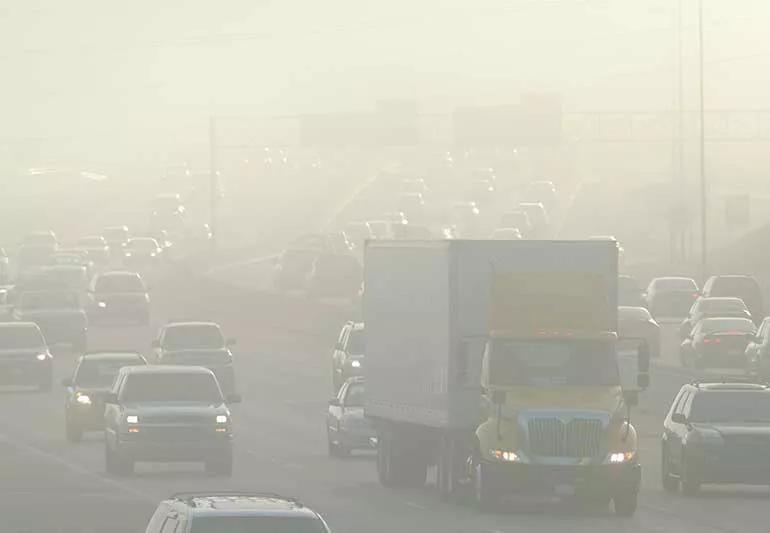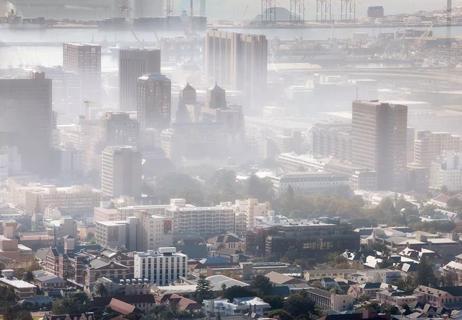The type, quantity and duration of your exposure determines your risk of injury or illness

What do you think of when you hear the word “pollution”? Do you think about industrial accidents like the Bhopal, India gas tragedy; the Chernobyl, Soviet Union nuclear accident; the Deepwater Horizon, Gulf of Mexico oil spill; or the East Palestine, Ohio train derailment?
Advertisement
Cleveland Clinic is a non-profit academic medical center. Advertising on our site helps support our mission. We do not endorse non-Cleveland Clinic products or services. Policy
What about natural disasters, like volcanic eruptions, floods or wildfires? Perhaps you’re a bit more conceptual, turning your thoughts to the existential threats of climate change, deforestation and the growing food crisis. Maybe you’re more practical, focusing first on adding a portable water purification system to your online shopping cart or checking the HEPA filter in your HVAC unit.
Pollution gives us a lot to think about — including our health. And it impacts all of us to varying degrees. From traffic emissions and pesticides to hurricanes and lead paint, what happens in the environment happens to our bodies, too.
We talked to pulmonologist Neha Solanki, MD, about some of the most common types of pollution, the risks they pose to your health and what you can do to protect yourself.
While we frequently talk about different types of pollution — like air pollution, water pollution, soil pollution, etc. — the reality isn’t that simple, Dr. Solanki notes. That’s because that’s not how our atmosphere works.
Do you remember learning about the water cycle in elementary school? Just in case, let’s refresh your memory.
The sun heats up the water in our soil, oceans, lakes, rivers and streams, vaporizing it (meaning, it turns into a gas). Large concentrations of water vapor form the clouds above our heads and, eventually, return to earth as precipitation (rain, snow or sleet). This complex process is always happening all around us, all the time.
Advertisement
Now imagine an oil spill in the ocean. While it might not be the first thing you think about when you see an oil spill on the news, crude oil contains toxic hydrocarbons that are dangerous to breathe in. So, air pollution is a significant concern in the immediate aftermath of a leak. But wait, there’s more.
When an oil spill happens, up to half of the crude evaporates in the first few days. These evaporated volatile organic chemicals (VOCs) can return to earth again, mixed in with our rainwater. And, even if most of the oil that didn’t evaporate after the spill is cleaned up, some of it will make it onto land, contaminating the soil.
So, an oil spill causes air, water and soil pollution, all of which could cause health issues for individuals exposed to it. As you read about the dangers of different types of pollution, keep in mind that these lists can — and do — blend together in the real world.
When discussing the health impacts of pollution, the length and intensity of exposure are important. There are two types of exposure: acute and chronic. They can both impact your health, Dr. Solanki says, but acute exposure is often easier to recognize and address.
Acute exposure happens when an individual is exposed to a sudden, significant amount of pollution for a concentrated amount of time. One of the most famous instances of acute exposure: September 11, 2001.
When the World Trade Center (WTC) Twin Towers collapsed, they sent toxic plumes into the air and produced fires that burned, in some cases, for several months. Multiple city blocks were covered in ash, debris and toxic particulate matter like asbestos, concrete and glass.
According to the U.S. CDC’s World Trade Center Health Program, hundreds of thousands of people in New York City inhaled polluted air in the immediate aftermath of the attack. They also ingested the toxic material and absorbed it through their skin. First responders — police, firefighters, emergency medical workers and search teams involved in the rescue, recovery and cleanup process — endured even greater exposure.
While an exposure may be acute, that doesn’t mean the health threat is acute. Some individuals had immediate reactions to being exposed to the “WTC cloud,” like cough, asthma and airway reactivity. But over the years, it’s become clear that exposure can also have long-term impacts. Many people developed cancer and aerodigestive disorders over time.
Chronic exposure is often less dramatic than acute exposure, but that doesn’t make it any less severe.
“Chronic exposure to pollution is very insidious,” Dr. Solanki says, “because people don’t tend to realize the effect that these pollutants are having on their health over time. They often end up having multiple conditions at once — heart problems, lung problems and cancer, for instance — and they can’t always pinpoint where the exposure is coming from.”
Advertisement
Dr. Solanki published an article in Pediatric Pulmonology that demonstrates how chronic exposure to pollution can manifest in our everyday lives. Her research found that children living in major cities tended to have more serious asthma symptoms when nitrogen dioxide (NO2) levels were high. One of the primary causes of those NO2 spikes: heavy traffic.
Secondhand smoke is another common example of chronic exposure. According to the CDC, tobacco smoke contains more than 7,000 different chemicals, including ammonia, hydrogen cyanide, butane and toluene.
For decades, people coexisted with secondhand smoke, which was a decidedly bad thing — secondhand smoke is known to cause cancer, heart disease, asthma and a host of other health issues. The American Cancer Society puts it bluntly: There is no such thing as a safe level of exposure to secondhand smoke. Exposure can be deadly, even when it isn’t chronic. Even thirdhand smoke is dangerous! That’s why indoor smoking bans are so common, both in the U.S. and in many countries around the world.
According to Dr. Solanki, air pollution is made of gases and particulate matter — solids or liquids so tiny that you can inhale them. It’s ambient, meaning it’s everywhere. But different places have different kinds and amounts of air pollution, depending on the circumstances. Common types of air pollution include TRAP (traffic-related air pollution), wildfires and factory emissions.
Advertisement
In the United States, the Environmental Protection Agency (EPA) has established a standard for acceptable levels of air pollution. “Most of the country actually does meet these levels,” Dr. Solanki notes. “But research shows that pollution levels that meet the guidelines set by the EPA still have negative effects on health. So, those guidelines are not strict enough.”
As we learned in grade school, most of the Earth is made of water — very little of which is drinkable as is. It’s mostly salt water.
Dr. Solanki explains that there are two different ways water can become contaminated:
In other words, water pollution can come from the sky, the ground and from, well … us.
As with water pollution, soil pollution can be the result of air or water pollution, but it can also happen directly. Soil contamination can look like littering, industrial waste disposal and — to put it delicately — our biological waste.
Light pollution is a topic that’s getting increasing attention from doctors. The artificial light we humans use every day not only impacts the plant and animal life around us, but also impacts our health. It’s a particular problem in urban areas, where lights can be hard to escape, even in the dead of night.
Advertisement
Research shows that sleeping with artificial light can contribute to cardiometabolic dysfunction, which is a fancy way to say issues with your heart, metabolism (think Type 2 diabetes) and weight.
There’s good news here: While light pollution is damaging our atmosphere in ways we’re just beginning to understand, we can protect ourselves against it by using blackout shades/curtains or an eye mask when we sleep.
If you have reason to believe you’ve been exposed to environmental hazards, there are several different symptoms to be on the lookout for:
| Air Pollution | Water Pollution | Soil Pollution | Light Pollution |
|---|---|---|---|
| Shortness of breath. | Nausea and vomiting. | Nausea and vomiting. | Eye strain. |
| Coughing or wheezing. | Diarrhea. | Fatigue. | Worsening vision. |
| Worsening asthma. | Skin rashes. | Headache. | Difficulty sleeping. |
| Allergy symptoms. | Earache. | Coughing or breathing problems. | Headaches or migraines. |
| Chest pain or palpitations. | Pink eye. | Skin rashes. | Anxiety or depression. |
| Eye or throat irritation. | Fever. | Chest pain. | Fatigue. |
| Air Pollution | |||
| Shortness of breath. | |||
| Water Pollution | |||
| Nausea and vomiting. | |||
| Soil Pollution | |||
| Nausea and vomiting. | |||
| Light Pollution | |||
| Eye strain. | |||
| Coughing or wheezing. | |||
| Water Pollution | |||
| Diarrhea. | |||
| Soil Pollution | |||
| Fatigue. | |||
| Light Pollution | |||
| Worsening vision. | |||
| Worsening asthma. | |||
| Water Pollution | |||
| Skin rashes. | |||
| Soil Pollution | |||
| Headache. | |||
| Light Pollution | |||
| Difficulty sleeping. | |||
| Allergy symptoms. | |||
| Water Pollution | |||
| Earache. | |||
| Soil Pollution | |||
| Coughing or breathing problems. | |||
| Light Pollution | |||
| Headaches or migraines. | |||
| Chest pain or palpitations. | |||
| Water Pollution | |||
| Pink eye. | |||
| Soil Pollution | |||
| Skin rashes. | |||
| Light Pollution | |||
| Anxiety or depression. | |||
| Eye or throat irritation. | |||
| Water Pollution | |||
| Fever. | |||
| Soil Pollution | |||
| Chest pain. | |||
| Light Pollution | |||
| Fatigue. |
As you can probably tell, it’s hard to distinguish the effects of pollution from other medical conditions. Unless there’s a major environmental disaster happening in your area, the only way to home in on a cause is to track your symptoms — and be aware of what’s happening in the places where you live and work.
It can be hard to know for sure if the health concerns you’re experiencing are related to pollution. Luckily, you don’t have to know that.
“If you live in an area that has a high degree of air pollution, for example, and if you have symptoms such as shortness of breath, coughing or wheezing, you should see a doctor,” Dr. Solanki states. “You may be able to get help before it becomes a chronic health issue that you have to live with.”
By now, you’re probably feeling a little bit nervous. It’s understandable: Pollution is a tough topic because it’s not something we can eliminate from our lives. But that doesn’t mean we have to just live with it either. Here are a few steps you can take to reduce your exposure to environmental health hazards:
It can be easy to feel defeated when we think about problems like pollution. They’re just so … big. How can we protect ourselves from forces seemingly beyond our control?
While we can’t avoid pollution completely, being aware of what’s happening in your area can help you know when to take extra precautions (more on those later). Having your finger on the pulse of your local environment can also give you some much-needed peace of mind.
Americans: Did you know that the EPA has a website that can tell you how the air quality is in your Zip code right now? It even has graphs that show you air quality trends in your area over the course of the day, week and month! Air quality is usually included on weather apps and your local news stations’ weather reports as well, so it’s easy to keep an eye on.
What about water pollution? If you live in the United States, your local government will issue boil water advisories if water contamination is significant enough to be hazardous to your health. If you aren’t the type to watch the local evening news, that’s OK. Many counties have “Water Off” pages on their websites, and most counties also make water quality reports publicly available, which can help you determine whether water quality is a concern where you live.
The CDC also consolidates data from local, state and nationwide sources on its National Environmental Public Health Tracking Network website.
It’s important to know how pollution impacts the area you call home. It’s also important to know if you’re specifically at risk of pollution-related complications. Here are a few key questions to ask yourself:
A little awareness can go a long way and — along with some blackout curtains — help you sleep a bit better.
Here are a few ways you can minimize your exposure to pollutants. You probably won’t be able to do all of them, but every little bit helps!
Many children of the 1990s grew up watching a cartoon called Captain Planet and The Planeteers. In the show, the spirit of the Earth gives a diverse group of youngsters magical rings. The rings grant them power over the elements: earth, wind, fire, water and — inexplicably — heart. When evildoers threaten the atmosphere, they combine their powers to summon Captain Planet: An environmentalist superhero who makes all the pollution magically disappear.
It was a really fun show. Unfortunately, pollution isn’t that easy to address.
But that doesn’t mean we’re powerless. We don’t control the elements — and our hearts only take us so far. But understanding what pollution is and doing what we can to protect ourselves against it can only improve our situation.
“We do the best we can with the information that we have,” Dr. Solanki emphasizes. If you’re concerned about the impact environmental hazards may be having on your health, do what you can to learn about the sources of pollution in your little corner of the world, and don’t be afraid to go to your doctor with questions. You’re not the only one looking for answers.
Learn more about our editorial process.
Advertisement

Breathing in toxic smoke can lead to serious health problems

Breathing in polluted air can harm your lungs, heart and more

Bottom line? Dress warm, be careful and plan ahead to get the most out of the season

Establish rules and have a safety plan in place

An ER doc shares tips for being careful while having fun

Make sure your wood has been split and stored for at least 6 months

When something like food or drink goes down your windpipe rather than your esophagus, it can cause coughing and sometimes choking

There’s no safe way to identify, handle, repair or remove asbestos yourself — it’s always a job for a professional

If you’re feeling short of breath, sleep can be tough — propping yourself up or sleeping on your side may help

If you fear the unknown or find yourself needing reassurance often, you may identify with this attachment style

If you’re looking to boost your gut health, it’s better to get fiber from whole foods